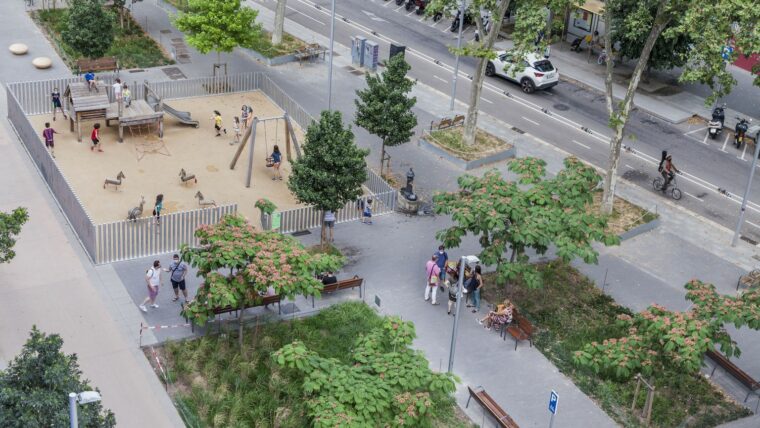More resilient against the climate crisis with 96% of measures completed or under way
The city declared the climate emergency in January 2020 and pledged to take a number of short and long-term measures to become carbon neutral by 2050. During this time, 96% of the measures set out in the Climate Emergency Declaration have either been completed or are in progress. These include adding greenery and pedestrian space, promoting the use of bicycles and public transport, the rollout of climate shelters and renewable energy, cutting waste and reducing the waste of food and water.
The goal of the Climate Emergency Declaration signed in 2020 was to become carbon neutral by 2050 and adapt the city to become more resilient and able to tackle the challenges of climate change.
Greener and healthier urban model
The rollout of the Barcelona Superblock model to foster community life and neighbourhood economies has been stepped up.
Work is currently under way on the green streets in L’Eixample, which will add 58,000 square metres of space for pedestrians, as well as in Via Laietana, the park in Pl. Glòries, Pi i Margall and others.
Urban greenery has also been increased, with another 44.6 hectares through various projects completed in the last four years. Notable examples include the remodelling of C/ Cristóbal de Moura, the Parc d’Antoni Santibruco, Av. Meridiana, the site where the former Cinema Niza stood and the area around the Mercat de Sant Antoni.
The increase in green areas is aimed at generating new spaces offering shade and comfortable temperatures while fostering a more pleasant urban landscape. In this respect, the city has also rolled out its network of climate shelters, with 134 for the winter and nearly 200 for the summer.
Priority for sustainable mobility
Work is in progress to increase and improve the city’s cycling infrastructure: an additional 30 kilometres of bike lanes have been created, bringing the total to 241, action taken to improve the connectivity of cycling paths, the segregation of lanes on road surfaces and pavements and more parking added.
On the metro network, accessibility has been improved at various stations and on board trains on lines 1 and 3, with work also carried out to allow for more frequent trains. The bus network continues to be renewed to make it more sustainable and bus lanes have been increased and updated.
Energy, waste and food
The city has doubled the energy it produces with municipal solar panels and the power supplied by the metropolitan public operator Barcelona Energia is now equivalent to the consumption of 100,000 households.
The door-to-door waste collection system in Sarrià and Sant Andreu has been consolidated, and in its first few weeks the new free textile collection service has already recovered 45 tonnes.
Initiatives have also been promoting healthy diets and the reuse of food, while the AgroVallbona project aims to transform the neighbourhood and consolidate it as a role model for urban agro-ecology.
Local people also play their part in adapting the city to the climate crisis. The Climate Assembly brought together hundreds of city people to agree on thirty proposals. This was the first initiative of this type to be organised in the Spanish state.






Tags associated with the news item
Related news
-
 Urban planning and infrastructures
Urban planning and infrastructures
Urban planning and infrastructures
Urban planning and infrastructuresSecond stage of the transformation of Carrer de Cristóbal de Moura approved
17/01/2021 10:49 h
-
 Urban planning and infrastructures
Urban planning and infrastructures
Urban planning and infrastructures
Urban planning and infrastructuresAgroVallbona: a window on the country to transform the neighbourhood
17/02/2023 11:56 h
-
 Environment and sustainability
Environment and sustainability
Environment and sustainability
Environment and sustainabilityProposals from members of the public to tackle the climate emergency
19/01/2023 20:06 h








